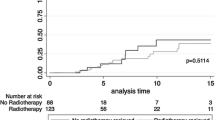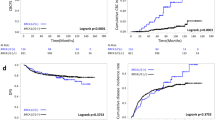Abstract
Women with BRCA1 and BRCA2 mutations have an elevated risk of breast cancer and ovarian cancer, but also of developing second primary breast cancer. BRCA1/2 mutation carriers with breast cancer must choose between breast conservation (BCT) and mastectomy (M) yet data on outcomes are limited. The purpose of this study is to compare long-term outcome following BCT and M in BRCA1/2 carriers. 655 women with BRCA1/2 mutations diagnosed with breast cancer and treated with BCT (n = 302) or M (n = 353) were identified and underwent follow-up to assess local, regional, and systemic recurrence. Local failure as first failure was significantly more likely in those treated with BCT compared to M, with a cumulative estimated risk of 23.5 vs. 5.5%, respectively, at 15 years (P < 0.0001); 15-year estimates in carriers treated with BCT and chemotherapy was 11.9% (P = 0.08 when compared to M). Most events appeared to be second primary cancers rather than failure to control the primary tumor. The risk of contralateral breast cancer was high in all groups, exceeding 40%, but was not statistically significantly different by use of adjuvant radiotherapy (RT) or not, suggesting no added risk from scatter RT at 10 and 15 years. There were no differences seen in regional or systemic recurrences between the BCT and M groups, and no difference in overall survival. In conclusion, BRCA1/2 mutation carriers with breast cancer have similar survival whether treated with M or BCT. However, women undergoing BCT have an elevated risk of a second in-breast event that is significantly reduced in the presence of chemotherapy. Contralateral breast cancer events are very common.



Similar content being viewed by others
References
Struewing JP, Hartge P, Wacholder S et al (1997) The risk of cancer associated with specific mutations of BRCA1 and BRCA2 among Ashkenazi Jews. N Engl J Med 336:1401–1408
Begg CB, Haile R, Borg A et al (2008) Variation of breast cancer risk amond BRCA1/2 carriers. JAMA 299:194–201
Fisher B, Anderson S, Bryant J et al (2002) Twenty-year follow-up of a randomized trial comparing total mastectomy, lumpectomy, and lumpectomy plus irradiation for the treatment of invasive breast cancer. N Engl J Med 347:1233–1241
Veronesi U, Cascinelli N, Mariani L et al (2002) Twenty-year follow-up of a randomized study comparing breast-conserving surgery with radical mastectomy for early breast cancer. N Engl J Med 347:1227–1232
Mann GJ, Thorne H, Balleine RM et al (2006) Analysis of cancer risk and BRCA1 and BRCA2 mutation prevalence in the kConFab familial breast cancer resource. Breast Cancer Res 8:R12
Phillips KA, Milne RL, Buys S et al (2005) Agreement between self-reported breast cancer treatment and medical records in a population-based breast cancer family registry. J Clin Oncol 23:4679–4686
Kaplan EL, Meier P (1958) Nonparametric estimation from incomplete observations. J Am Stat Assoc 53:457–481
Gooley TA, Leisenring W, Crowley J et al (1999) Estimation of failure probabilities in the presence of competing risks: new representation of old estimators. Stat Med 18:695–706
Pepe M (1991) Inference for events with dependent risks in multiple endpoints studies. J Am Stat Assoc 86:770–778
Clarke M, Collins R, Darby S et al (2005) Effects of radiotherapy and of differences in the extent of surgery for early breast cancer on local recurrence and 15-year survival: an overview of the randomized trials. Lancet 366:2087–2106
Schwartz GF, Veronesi U, Clough KB, et al (2006) In: Proceedings on the consensus conference on breast conservation, April 28 to May 2, 2005, Milan, Italy. Cancer 107:242–250
Turner BC, Harrold E, Matloff E et al (1999) BRCA1/BRCA2 germline mutations in locally recurrent breast cancer patients after lumpectomy and radiation therapy: implications for breast-conserving management in patients with BRCA1/BRCA2 mutations. J Clin Oncol 17:3017–3024
Donegan WL, Perez-Mesa CM, Watson FR (1966) A biostatistical study of locally recurrent breast carcinoma. Surg Gynecol Obstet 122:529–540
Anderson SJ, Wapnir I, Dignam JJ et al (2009) Prognosis after ipsilateral breast tumor recurrence and locoregional recurrences in patients treated by breast-conserving therapy in five National Surgical Adjuvant Breast and Bowel Project protocols of node-negative breast cancer. J Clin Oncol 27:2466–2473
Wapnir IL, Anderson SJ, Mamounas EP et al (2006) Prognosis after ipsilateral breast tumor recurrence and locoregional recurrences in five National Surgical Adjuvant Breast and Bowel Project node-positive adjuvant breast cancer trials. J Clin Oncol 24:2028–2037
Fourquet A, Stoppa-Lyonnet D, Kirova YM et al (2009) Familial breast cancer: clinical response to induction chemotherapy or radiotherapy related to BRCA1/2 mutations status. Am J Clin Oncol 32:127–131
Kauff ND, Domchek SM, Friebel TM et al (2008) Risk-reducing salpingo-oophorectomy for the prevention of BRCA1- and BRCA2-associated breast and gynecologic cancer: a multicenter prospective study. J Clin Oncol 26:1331–1337
King MC, Wieand S, Hale K et al (2001) Tamoxifen and breast cancer incidence among women with inherited mutations in BRCA1 and BRCA2: National Surgical Adjuvant Breast and Bowel Project (NSABP-P1) Breast Cancer Prevention Trial. JAMA 286:2251–2256
Bines J, Oleske DM, Cobleigh MA (1996) Ovarian function in premenopausal women treated with adjuvant chemotherapy for breast cancer. J Clin Oncol 14:1718–1729
Pierce LJ, Levin AM, Rebbeck TR et al (2006) Ten-year multi-institutional results of breast-conserving surgery and radiotherapy in BRCA1/2-associated stage I/II breast cancer. J Clin Oncol 24:2437–2443
Verhoog LC, Brekelmans CTM, Seynaeve C et al (1998) Survival and tumour characteristics of breast cancer patients with germline mutations of BRCA1. Lancet 351:316–321
Eccles D, Simmonds P, Goddard J et al (2001) Familial breast cancer: an investigation into the outcome of treatment for early stage disease. Fam Cancer 1:65–72
Robson M, Levin D, Federici M et al (1999) Breast conservation therapy for invasive breast cancer in Ashkenazi women with BRCA gene founder mutations. J Natl Cancer Inst 91:2112–2117
Haffty B, Harold E, Khan A et al (2002) Outcome of conservatively managed early-onset breast cancer by BRCA1/2 status. Lancet 359:1471–1477
Kirova YM, Stoppa-Lyonnet D, Savignoni A et al (2005) Risk of breast cancer recurrence and contralateral breast cancer in relation to BRCA1 and BRCA2 mutation status following breast-conserving surgery and radiotherapy. Eur J Cancer 41:2304–2311
Garcia-Etienne C, Barile M, Gentilini O, et al. Breast-conserving surgery in BRCA1/2 mutation carriers: Are we approaching an answer? Ann Surg Oncol. doi 10.1245/s10434-009-0638-7
Acknowledgments
This research was supported by the Breast Cancer Research Foundation (LJP, SDM); the Colebatch Clinical Research Fellowship of the Cancer Council Victoria (KAP), the National Health and Medical Research Council (NHMRC) of Australia (#145684, 288704, 454508) and grants from the National Breast Cancer Foundation, the NHMRC and by the Queensland Cancer Fund, the Cancer Councils of New South Wales, Victoria, Tasmania and South Australia, and the Cancer Foundation of Western Australia (kConFab); Susan G. Komen Breast Cancer Foundation (BGH); Dana Farber/Harvard Cancer Center SPORE in Breast Cancer (JEG); and Cancer Genetics Network (HHSN21620074400C) (SMD). We thank follow-up study investigators, research nurses and staff at kConFab and all study sites, the heads and staff of the Australian and New Zealand Family Cancer Clinics, and the families who contribute to kConFab and to this international collaboration.
Conflict of interest statement
No authors have a conflict of interest with the content of this manuscript.
Author information
Authors and Affiliations
Corresponding author
Rights and permissions
About this article
Cite this article
Pierce, L.J., Phillips, KA., Griffith, K.A. et al. Local therapy in BRCA1 and BRCA2 mutation carriers with operable breast cancer: comparison of breast conservation and mastectomy. Breast Cancer Res Treat 121, 389–398 (2010). https://doi.org/10.1007/s10549-010-0894-z
Received:
Accepted:
Published:
Issue Date:
DOI: https://doi.org/10.1007/s10549-010-0894-z




